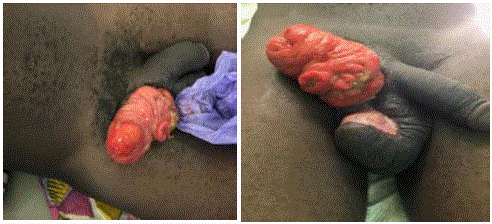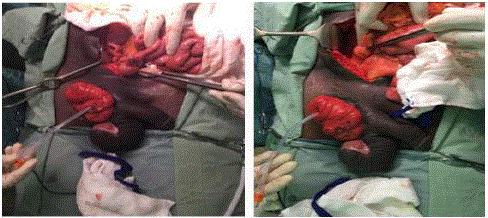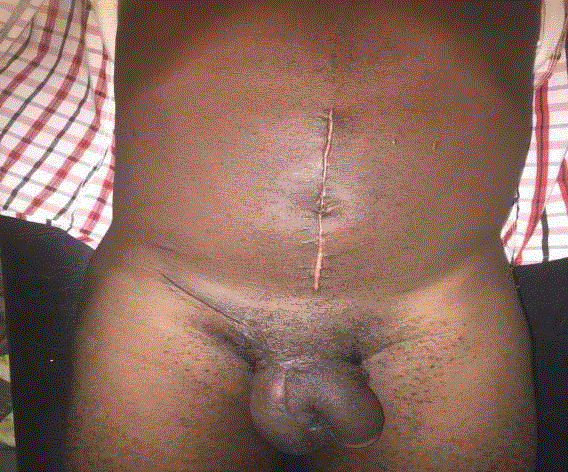Case Report
Entero-Scrotal Fistula in an Adult: A Complication of Traditional Health Care Practice in Ghana
Joachim KA Amoako1*, Theodore Wordui2, Philemon K Kumassah2, Joelle M Amissah2 and Michael Ohene-Yeboah1
1Department of Surgery, University of Ghana, Ghana
2Department of Surgery, Catholic Hospital, Ghana
*Corresponding author: Joachim KA Amoako, Department of Surgery, School of Medicine and Dentistry, University of Ghana, PO Box GP 4236, Accra, Ghana
Published: 14 Jul, 2018
Cite this article as: Amoako JKA, Wordui T, Kumassah
PK, Amissah JM, Ohene-Yeboah M.
Entero-Scrotal Fistula in an Adult: A
Complication of Traditional Health Care
Practice in Ghana. Clin Surg. 2018; 3:
2025.
Abstract
Inguinal hernias are common in Ghanaian men. However, access to inguinal hernia surgery is
limited. Considerable morbidity and significant mortality are associated with untreated, large, long
standing inguinal hernias. Some patients with inguinal hernias seek relief from traditional health
care providers. We present a case of entero-scrotal fistula in a 32-year-old man following treatment
of an obstructed inguinal hernia by a traditional health care practitioner. A laparotomy was done
with a limited right hemicolectomy and Nylon-darn repair of his inguinal hernia in a district general
hospital with his full recovery.
Keywords: Inguinal hernia; Entero-scrotal fistula; Traditional health care practitioner
Introduction
Inguinal hernias are a common surgical condition worldwide. In Ghana, inguinal hernias occur in 10.8% of men [1]. However, the surgical repair rate is estimated at a low 30 per 100, 000 of the population per year [2]. Untreated inguinal hernia limits agricultural activity such as crop production and fishing and social life [3]. As a result of limited understanding of inguinal hernia disease process, high cost of (orthodox) health care and inadequate capacity for surgical care at the health facilities in rural communities, many patients with untreated inguinal hernias seek help from traditional health care practitioners. We present a case of entero-scrotal fistula in one of these patients.
Case Presentation
A 32-year-old man presented to a district general hospital, complaining of a discharging wound
on the scrotum for one month. Over the previous 12 months, he had been aware of a mass in his
right groin which occasionally disappeared. He experienced an occasional dragging pain in the mass
which was worse anytime he engaged in manual activity. The mass usually disappeared with relief
of his pain when he lay down for some time. Four weeks prior to presentation, he experienced
severe pain in the swelling. This time the swelling did not disappear even when he lay down. Over
the next four days he developed abdominal pain, vomited several times and noticed he had become
very weak. He consulted the traditional health care practitioner who was his brother. Following
treatment, the abdominal pain resolved, and he stopped vomiting. However, he soon noticed that he
did not pass stool or flatus. There was a persistent offensive discharge from a wound on the scrotum.
The wound failed to heal after a month. He therefore decided to go to the hospital.
On clinical examination, he was mildly dehydrated. He was not pale or jaundiced. His body
temperature was 36.9oC. His blood pressure was 132/68 mmHg and his pulse rate was 76 beats per
minute. Clinical examination of the chest revealed no abnormalities. His abdomen was soft, with
no areas of tenderness, guarding or rebound tenderness. There was a 10 cm long segment of viable
bowel that had eviscerated through a right groin wound (Figure 1A and 1B). The mucosa of the
bowel was exposed. There was discharge of feculent fluid from the bowel. The skin wound edges
were clean and healing and the scrotal skin was normal.
His haemoglobin, white blood cell count, platelets count, creatinine, urea, potassium, sodium and
serum albumin levels were normal. The patient was resuscitated and informed consent was obtained
for a laparotomy under general anesthesia. At laparotomy, urethral catheters were passed into two
openings in the eviscerated bowel. It was found by palpation for the catheters intra-abdominally
that a larger supero-lateral opening in the eviscerated bowel was continuous with the ascending
colon while a smaller infero-medial opening was continuous with the
terminal ileum (Figure 2A and 2B). The right testis was exposed. A
limited right hemicolectomy was performed with end-to-end handsewn
ileocolic anastomosis. The inguinal incision was extended
laterally and herniotomy and Nylon-darn herniorrhaphy were
done. A right orchidopexy was also performed. The patient had an
uneventful postoperative period and was discharged home seven days
after the operation (Figure 3).
Figure 1A and 1B
Figure 1A and 1B
Photographs showing the fistula at presentation (A) and
before skin preparation in theatre (B).
Figure 2A and 2B
Figure 3
Discussion
The prevalence of inguinal hernias in Ghanaian men is 10.8% with
a repair rate estimated at just 30 per 100, 000 of the population per
year [1,2]. In contrast, the repair rate in the United States of America
is 275 per 100, 000 of the population per year [4]. Access to inguinal
hernia surgery in Ghana is limited in part by lack of trained surgeons
and anaesthetists, the cost of surgery and anaesthesia, and the lack of
patient education on the disease. We present a case of entero-scrotal
fistula in a young Ghanaian male following incision of an obstructed
right inguinoscrotal hernia as treatment by a traditional health care
practitioner who was his brother. He had no electrolyte abnormalities
and underwent a laparotomy with a limited right hemicolectomy and
nylon darn repair of his hernia with an uneventful recovery. The fact
that the traditional health care practitioner is brother to the patient
may have played a role in his decision to seek initial care from him.
Entero-scrotal fistulas commonly occur spontaneously in neglected
Richter’s hernias. The obstruction to less than two thirds of the
circumference of the bowel wall in some cases allows for continuous
passage of luminal contents. Therefore, symptoms of intestinal
obstruction do not occur and diagnosis is difficult or delayed. The
prolonged obstruction to the blood supply of part of the bowel wall
predisposes it to gangrene, necrosis and fistulation. These fistulae
usually occur in the paediatric age group and are rare in adults [5-7].
Indeed, a previous report from Ghana was in an adult male who lost
two months of farm work [5].
Reports of entero-scrotal fistulae following incision by a traditional
health care practitioner are rare. Nwabunike (1984) reported three
cases of entero-scrotal fistulae following incision by traditional health
care providers who mistook the obstructed hernias for abscesses [4].
The incision in the obstructed hernia in this index case went deep
through the trapped caecum, and led to the discharge of its luminal
content. This allowed the proximal bowel to empty continuously over
the next month but without continuity with the distal segment. The
integrity of the intra-abdominal small bowel was not disturbed, and
this enabled adequate absorption of food nutrients and may partly
explain his relatively good nutritional status at presentation. In the
absence of scrotal necrosis, the bowel healed to the scrotal skin edges
resulting in maturation of the fistula.
Conclusion
This unique case report of a complication and associated morbidity of treatment of inguinal hernia by a traditional health care practitioner in Ghana is preventable. It is further evidence for concerted effort to increase the elective inguinal hernia repair rate in Ghana.
References
- Ohene-Yeboah M, Beard JH, Frimpong-Twumasi B, Koranteng A, Mensah S. Prevalence of Inguinal Hernia in Adult Men in the Ashanti Region of Ghana. World J Surg. 2016;40(4):806-12.
- Grimes CE, Law RS, Borgstein ES, Mkandawire NC, Lavy CB. Systematic review of met and unmet need of surgical disease in rural sub-Saharan Africa. World J Surg. 2012;36(1):8-23.
- Nwabunike TO. Enterocutaneous fistulas in Enugu Nigeria. Dis Colon Rectum. 1984;27(8):542-4.
- Rutkow IM. Demographic and socioeconomic aspects of hernia repair in the United States in 2003. Surg Clin North Am. 2003;83(5):1045-51.
- Ohene-Yeboah M. Entero-scrotal fistula in a Ghanaian adult: a case report of spontaneous rupture of a neglected strangulated inguinal hernia. Hernia. 2011;15(4):455-7.
- Rattan KN, Garg P. Neonatal scrotal fecal fistula. Pediatr Surg Int. 1998;13(5-6):440-1.
- Ghritlaharey RK, Shrivastava DK, Kushwaha AS. Spontaneous scrotal faecal fistula in infant: a case report and literature review. J Clin Diag Res. 2007;4:303-6.



